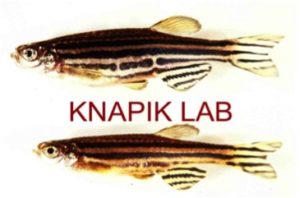Research
Understanding mechanisms of protein transport and secretion through modeling of human diseases
The Knapik laboratory uses in vivo approaches in zebrafish (Danio rerio) to model and manipulate the genetic and developmental processes that underlie the pathophysiology of human disease. We use genetic mutations induced by CRISPR/Cas9 genome editing or chemically-induced random variants to assess disease phenotypes, gene function, and pathway interactions. In parallel with the zebrafish models of human diseases, we also use mammalian cell culture and biochemical approaches.
We have focused our research on three main areas:
- The mechanisms and pathways directing extracellular matrix traffic and deposition
- The pathophysiology of human diseases, including developmental and neuropsychiatric disorders
- Modeling human variants for drug development and testing
Our laboratory is actively seeking motivated individuals to contribute to our work in an effort to better understand how disruptions in basic cellular and developmental processes can cause human diseases, including developmental and neuropsychiatric disorders.
Rotation Projects
- Modeling of human diseases, analysis of craniofacial malformations as comorbid phenotypes to neuropsychiatric disorders
- Investigation of cargo selection by inner COPII coat component, SEC24C during brain development using CRISPR/Cas9 genome editing strategy
- Imaging-based gastrointestinal motility assays to analyze Sar1b-linked lipid absorption defects
- Validation of BioVU phenome findings through modeling in zebrafish (disease gene discovery)
- Transcriptional regulation of secretory activity by CREB3L2
- Discovery of CREB3L2 transcriptional targets in RNA-seq dataset
- Functional validation of targets by genetic replacement experiments using Tol2kit genomic integration method
